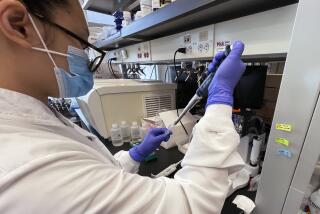Patients Have High Level of AIDS Virus : Health: New measuring techniques may help researchers determine which drugs are most effective against the deadly disease.
- Share via
Individuals infected with the AIDS virus have much higher concentrations of the virus in their circulation than previously thought, according to studies by researchers at Cedars-Sinai Medical Center in Los Angeles and the University of Washington in Seattle published in today’s issue of the New England Journal of Medicine.
New techniques for measuring the AIDS virus in the blood led to the findings and may also help researchers determine which drugs are most likely to be effective against the deadly virus. The new studies, along with a previous report from the National Institute of Allergy and Infectious Disease, suggest that high levels of the AIDS-causing human immunodeficiency virus in the circulation cause the widespread immune system damage that leads to AIDS.
“We are asking old questions with better techniques and coming up with different answers,” said Dr. David D. Ho, the leader of the Cedars-Sinai research team. “There has been a general misconception that there is not a lot of (AIDS) virus around, and therefore the small viral burden was not sufficient to account for the immune destruction that was seen.”
Some AIDS experts said the studies suggested that early drug treatment might help control the AIDS virus indefinitely and prevent the development of disease.
“The correlation between increasing viral replication and disease progression . . . provides strong theoretical support for early treatment (with antiviral drugs),” David Baltimore and Dr. Mark B. Feinberg of the Whitehead Institute for Biomedical Research in Cambridge, Mass., wrote in an editorial for the New England Journal published along with the studies.
The three research teams have all developed techniques that directly measure the amount of AIDS virus in the blood stream. Some of the differences in their results may reflect differences in the techniques or the experiments performed.
The studies all confirm the widely held view that individuals with AIDS are more likely to transmit the AIDS virus to others than asymptomatic individuals. This is because they have higher concentrations of the virus in their circulation.
The Cedars researchers isolated the AIDS virus from both the white blood cells and the plasma--the liquid part of the blood--of the 54 infected patients studied who were not receiving antiviral treatment, such as AZT.
The AIDS virus can infect certain white blood cells, such as T4 lymphocytes and macrophages. The Cedars researchers found that the typical number of such cells that were infected varied more than a hundredfold, from 1 in 50,000 cells in infected, asymptomatic patients to 1 in 400 cells in AIDS patients. Similar differences were found in tests of plasma.
The new figures are between 100 and 1,000 times higher than previous estimates of the amount of virus in the circulation.
The results for white blood cells were similar to those that researchers in the laboratory of National Institute of Allergy and Infectious Disease Director Dr. Anthony S. Fauci published in the July 21 issue of the journal Science.
University of Washington researchers, in the laboratory of Dr. Lawrence Corey, isolated the AIDS virus from the white blood cells of 97% of the 213 patients tested, but from the plasma of only 23% of those with asymptomatic infections and 82% of those with AIDS.
The Cedars researchers also found a 94% reduction in the amount of virus in the plasma of seven patients with AIDS or AIDS-related complex receiving AZT treatment although there were no “consistent” changes in the number of infected cells.
According to Ho, measurements of the amount of virus in the circulation might be useful to monitor the effectiveness of experimental AIDS drugs.






